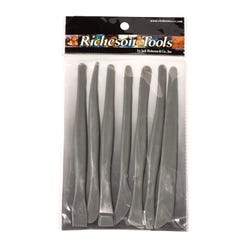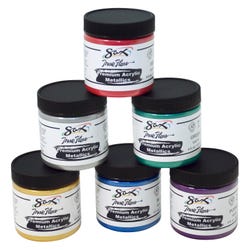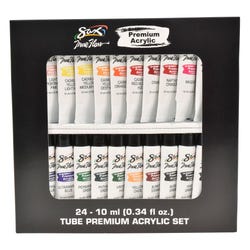Louise Nevelson Inspired Relief Sculptures

Description
Lesson Plan and Artwork by Phyllis M. Annett
Inspired by the monumental, monochromatic wall sculptures by 20th-Century sculptor, Louise Nevelson, students will develop their own version of a relief sculpture using carving block, matte board, paint, ink and found objects.
Objectives
- Students will know the work of Louise Nevelson and use this knowledge as a jumping-off point to develop their own version of a relief sculpture.
- Students will know differences in the types of relief and base relief sculpture.
- Students will use mixed media to create the construction.
Supplies Needed
Acrylic Metallic Paint, 2.5 oz, Set of 4
Acrylic Set, 0.34 oz, Set of 24
Gloss Medium and Varnish, Quart
Basic Value Brush Sets
No. 8 Ultra-Black Mounting Board, 11x14", Pack of 40
Mini Cut Edge Panels, White, Set of 180
Mini Cut Edge Panels, Black, Set of 180
Student Modeling Tool Set of 7
Carving Foam, 4-1/2 x 6 x 1/2 in, Pack of 36
Stylus Sticks, Pack of 100
*Here are the supplies needed for this lesson plan for reference. Find a convenient carousel of shoppable products for this lesson below.
Standards
Standard #2: Organize and develop artistic ideas and work.
Standard #3: Define and complete artistic work.
Standard #5: Develop and refine artistic work for presentation.
Standard #6: Convey meaning through the presentation of artistic work.
Standard #9: Apply criteria to evaluate artistic work.
Standard #11: Relate artistic ideas and works with societal, cultural and historical context to deepen understanding.
Instructions
1
Have a discussion, with visuals of the work of American sculptor Louise Nevelson. She made monumental-sized, monochromatic wooden wall relief sculptures that included found wooden objects. She was very much influenced by the work of Hans Hoffaman, one of her teachers who taught his artists self-discipline by having them work in monochromatic color schemes. She also admired the Cubistic work of Pablo Picasso, Native American and Mayan sculpture and the works of Diego Rivera and Frida Kahlo. Her most famous work, Sky Cathedral, was exhibited at the Museum of Modern Art in 1958 alongside works by Robert Rauschenberg and Jasper Johns.
2
Inform students they will be making their own relief sculpture inspired by the work of Louise Nevelson. The work will be mostly black for drama but students may add designs and even paintings on the various surfaces they create by building their sculpture. The result will be a relief sculpture on a matte board surface, reminiscent of Louise Nevelson’s wall and free-standing sculptures. Show students the materials that they will be using. Give tips and demonstrate to students how to cut carving blocks with Stylus Sticks and how to cut the matte boards with knives and scissors and guided by the edge of the rulers. Stress safety points to keep all safe while working.
3
Have students gather materials and give them an 11”x14” piece of black mounting board to represent a wall, on which the sculptural pieces will be built. Using the mini-panel pieces, a carving block, and pieces of black mounting board, have students start to build and glue together their constructions. A good tip for students is to make grooves into the carving blocks to add pieces of matte board into the material. Tools can include Stylus Sticks, scissors and X-ACTO knives. Cut shapes from all the materials. Keep building and adding shapes to the piece as you go along.
4
Inspire students, as they work, to refer to the work of Louise Nevelson. Keep the group grounded in the basic idea of Nevelson’s relief sculptures, with their box-like constructions that contained interesting shapes.
5
Inform students that they can cut shapes out of all the materials to add interest. Make notches and holes to knit materials through areas until a pleasing construction emerges.
6
Paint and highlight with the Acrylic Metallic Paints to enhance the black pieces. Note the carving foam must be painted to seal its surface and unpainted areas should be varnished with the Clear Tempera Varnish.
7
Discuss finished work and be sure to appreciate everyone’s efforts.
8
Display work for all to see and understand the concept of relief sculpture.







